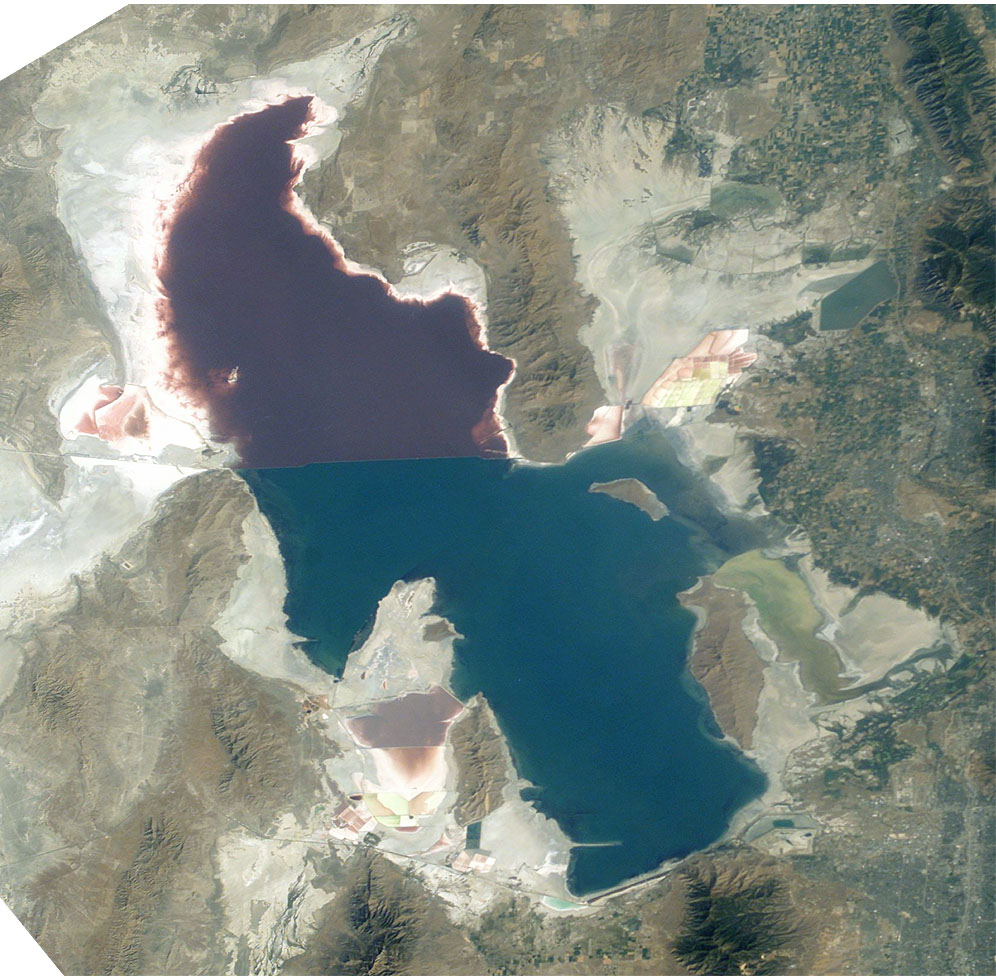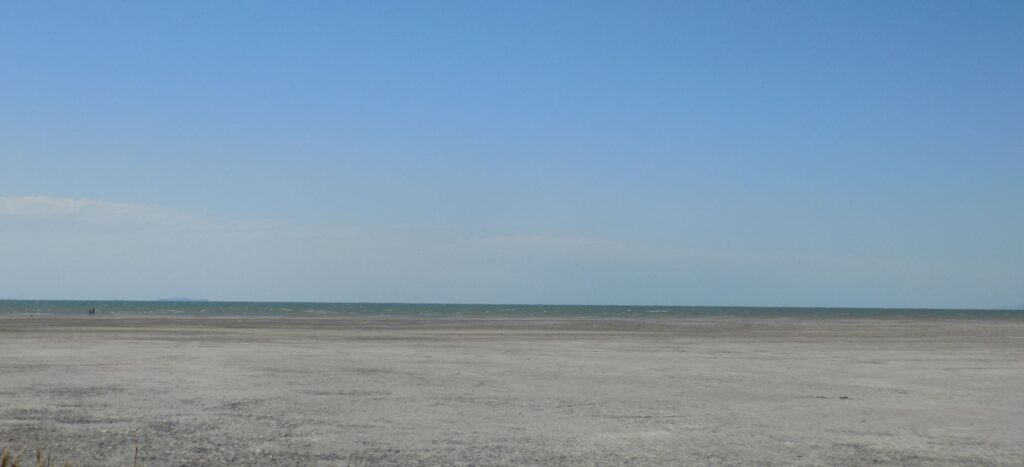Headnote.
For those of you who have read all the posts from my 2017 trip to Arizona and Utah if this post seems familiar, you’re not mistaken. It’s lifted almost verbatim from a section of the post titled “The Salt Lake – Great yet not so great.” So, if you’re not in the mood for a review, you should skip this post entirely. If you’re new to my travels and want a lesson about the Great Salt Lake, read on.
It’s shrinking! Shrinking! Oh, what a world.
Let’s start with what’s great about the Great Salt Lake. The first point is simple and straightforward: It’s the largest lake west of the Mississippi River and the largest salt lake in the Western Hemisphere. How big is it or, more accurately, how big was it? Until the 21st century, in a typical year, its surface area averaged 1,700 square miles though it could swell to more than 2,100 square miles. So, in a typical year, it was larger than the state of Rhode Island and, in those bigger years, larger than the land area of Delaware as well.
However, by 2016, the lake covered an area barely larger than 1,000 square miles. Its surface elevation, which peaked at 4,212 feet in 1986 equaled its lowest point of 4191 feet to which it first declined in 1963. Because the lake has an average depth of only 14 feet (35 feet at its deepest point) a foot of water loss can make a significant difference in its total size. Here’s what that can look like (from accuweather.).
Here’s a 2021 update from water.utah.gov:.
The average daily value of the Great Salt Lake hit a new record low July 23, 2021 (reported July 24) when it dropped to 4191.3 as measured at the SaltAir gauge location. Lake levels continued to drop until fall storms moved in and agricultural irrigation ended for the season. Oct. 15-18, the lake’s elevation was 4190.3, a new record low. Until the extreme drought of 2021, the previous record low was set in October 1963, with an elevation of 4191.35, rounded to 4191.4 to conform with current data collection and a recorded size of 950 square miles. (In 1963, levels were measured to the hundredth. Today, they are measured to the tenth of a foot.) In 1986, the surface area was at the historic high of 3,300 square miles and an elevation of 4,211.65. USGS keeps records of the lake dating back to 1847 when the pioneers first settled in Utah.
How the lake came to be.
As the glaciers retreated at the end of the last glacial maximum, the process created Lake Bonneville which was actually a freshwater lake. (Bonneville is named in honor of the French explorer Benjamin Bonneville who, in 1837, was the first to map the outlines of the Great Salt Lake.) At 325 miles long, 135 miles wide and 1,000 feet deep, Lake Bonneville was about 1.4 times the size of Lake Superior so it was enormous.
About 17,000 years ago, Lake Bonneville overflowed at Red Rock Pass in Idaho and a yearlong flood ensued during which time the lake lost about 375 feet of water depth. As it shrank, all the minerals in it — including salt — concentrated into steadily less water and over time, the modern Great Salt Lake emerged about 10,000 years ago. (All freshwater bodies have some mineral content because rainwater leaches it from rocks and soil.)
If you look at the image above, you’ll see that the lake is fed by three rivers – the Jordan, Weber, and Bear. You need to note this for two reasons – one of which will become important later in the discussion. For now, just note that three flow in but none flow out. This makes the Great Salt Lake an endorheic or terminal lake. (An endorheic lake or basin is a drainage basin that normally retains water and allows no outflow to other external bodies of water, such as rivers or oceans.)
Left to only natural processes, the Great Salt Lake, like any terminal lake, holds everything that enters it except any water it loses to evaporation and these rivers empty a lot more than merely water into the Great Salt Lake. Together, the three rivers make an annual deposit of between 1,100,000 and 2,200,000 tons of leftover minerals – mostly salt – from the extinct Lake Bonneville.
In the map above, the northern section of the lake is called Gunnison Bay while the southern section bears the name Gilbert Bay. Since all three rivers flow into the Gilbert Bay section of the lake, the northern arm is naturally more saline holding steady at just below 28 percent while the southern arm can fluctuate between as low as six percent or as high as 27 percent.
Natural processes aren’t the only forces at work on the lake, however. For example, five businesses extract salt and other minerals from the Great Salt Lake through solar evaporation ponds. Although no food-grade salt comes from the lake, the extracted salt is used for deicers, road salt, water softeners, and salt licks for livestock.
Two lakes in one.
In the course of my research about the Great Salt Lake, I happened across this rather curious NASA satellite image that provides a stark contrast between Gunnison and Gilbert Bays:
When I saw the two distinct colors, it fed a new mental tributary down which my research would flow – a not uncommon occurrence. Although I knew about the water inflow and salinity differences between the northern and southern sections of the lake, I didn’t think that alone would account for such a stark difference in coloration particularly one that seemed so definitive. I was right.
The difference has to do with the completion of the first transcontinental railroad in 1869 at Promontory Point – just north of the small island in the upper right of the blue part of the lake. In 1904, the Southern Pacific Railroad built a causeway across the lake that created not merely a shorter route that saved 42 miles but one of lesser grade and curvature that generated even greater time savings.
Initially, the causeway consisted of two earth and rock-fill embankments extending from each side of the lake that were joined by a 12 mile open, wooden trestle that allowed the continuation of the natural exchange of water between the two bays. Maintaining the trestle proved to be costly and by the early 1950s, when maintenance costs became too high, the rail company dismantled the trestle and replaced it with a solid rock-filled causeway. The picture shows the result.
The open structure of the trestle allowed for the free mixing of brine water between the north and south arms of the lake. The solid causeway effectively divided the lake into two bodies of water halting the mixing of water leading to some unanticipated environmental consequences.
Let’s return to the geography of the three rivers. Since they all feed the lake south of the causeway, the northern arm continued to experience the natural hydrological process of evaporation but with no inflow to replace any of the lost water. Its salinity increased to the point where the water became too saline for even one of the few species of plant or animal – brine shrimp – to survive the high salinity.
Eventually, in 1988 in an attempt to rectify or at least mitigate the damage, a 30 meter breach was created in the causeway. That first effort allowed the elevations and salinity to equalize to a certain extent. Still later, three large pumps were installed to keep salinity in the north arm at saturation levels about 27 percent while the south arm continues its natural fluctuation.
But the damage couldn’t be fully repaired and the salinity difference has created two different ecosystems on the lake that account for the different coloration. The south arm is dominated by blue-green algae, which colors its water green. On the north arm, higher salt content has promoted the dominance of a different type of algae called Dunaliella Salina. The north arm’s wine red color results from the beta-carotene and bacteria this alga releases.
And speaking of bacterial emissions, I was fortunate not to experience the effects of bacterial effluvia that so many in Salt Lake City cope with from time to time. As you can see in the photo above, it was a long walk across a stretch of sand to the water’s edge where I had to at least dip my toes. The Great Salt Lake is famous for occasionally emitting rotten egg odor. It’s a natural process as some species of bacteria residing in the lake bed exhale hydrogen sulfide. When that bacterial count is high, the lake emanates the unpleasant odor associated with that molecule.
On my walk across that long stretch of exposed lake bed, I encountered something else for which the lake is famous – brine flies. Although the flies are said not to bite people, I found their preponderant swarming presence discomfiting enough that, once my toe touched the water, I quickly retreated. I tried to capture the flies in one of my photos but this video does a better job (even if it’s a little shaky).


